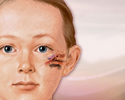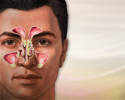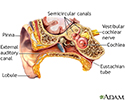Earache
Otalgia; Pain - ear; Ear painAn earache is a sharp, dull, or burning pain in one or both ears. The pain may last a short time or be ongoing. Related conditions include:
- Otitis media
-
Swimmer's ear
Swimmer's ear
Swimmer's ear is inflammation, irritation, or infection of the outer ear and ear canal. The medical term for swimmer's ear is otitis externa. Swimme...
 ImageRead Article Now Book Mark Article
ImageRead Article Now Book Mark Article -
Malignant otitis externa
Malignant otitis externa
Malignant otitis externa is a disorder that involves infection and damage of the bones of the ear canal and at the base of the skull.
 ImageRead Article Now Book Mark Article
ImageRead Article Now Book Mark Article
Considerations
The symptoms of an ear infection may include:
- Ear pain
-
Fever
Fever
Fever is the temporary increase in the body's temperature in response to a disease or illness. A child has a fever when the temperature is at or abov...
 ImageRead Article Now Book Mark Article
ImageRead Article Now Book Mark Article - Fussiness
- Increased crying
- Irritability
Many children will have minor hearing loss during or right after an ear infection. Most of the time, the problem goes away. Lasting hearing loss is rare, but the risk increases with the number of infections.
Causes
The eustachian tube runs from the middle part of each ear to the back of the throat. This tube drains fluid that is made in the middle ear. If the eustachian tube becomes blocked, fluid can build up. This may lead to pressure behind the eardrum or an ear infection.
Ear infection
Otitis is a term for infection or inflammation of the ear.

Ear pain in adults is less likely to be from an ear infection. Pain that you feel in the ear may be coming from another place, such as your teeth, the joint in your jaw (temporomandibular joint), or your throat. This is called referred pain.
Temporomandibular joint
Temporomandibular joint and muscle disorders (TMJ disorders) are problems that affect the chewing muscles and joints that connect your lower jaw to y...

Causes of ear pain may include:
-
Arthritis of the jaw
Arthritis
Arthritis is inflammation or degeneration of one or more joints. A joint is the area where 2 bones meet. There are more than 100 different types of...
 ImageRead Article Now Book Mark Article
ImageRead Article Now Book Mark Article -
Short-term (acute) ear infection
Short-term (acute) ear infection
Suspected ear infections are one of the most common reasons parents take their children to their health care provider. The most common type of ear i...
 ImageRead Article Now Book Mark Article
ImageRead Article Now Book Mark Article -
Long-term (chronic) ear infection
Long-term (chronic) ear infection
Chronic ear infection is fluid, swelling, or an infection behind the eardrum that does not go away or keeps coming back. It may cause long-term or p...
 ImageRead Article Now Book Mark Article
ImageRead Article Now Book Mark Article -
Ear injury from pressure changes (from high altitudes and other causes)
Ear injury from pressure changes
Ear barotrauma causes discomfort in the ear due to pressure differences between the inside and outside of the eardrum. It may include damage to the ...
 ImageRead Article Now Book Mark Article
ImageRead Article Now Book Mark Article -
Object stuck in the ear or buildup of ear wax
Object stuck in the ear
Ear emergencies include objects in the ear canal, ruptured eardrums, sudden hearing loss, and severe infections.
 ImageRead Article Now Book Mark Article
ImageRead Article Now Book Mark Article -
Hole in the eardrum
Hole in the eardrum
A ruptured eardrum is an opening or hole in the eardrum. The eardrum is a thin piece of tissue that separates the outer and middle ear. Damage to t...
 ImageRead Article Now Book Mark Article
ImageRead Article Now Book Mark Article -
Sinus infection
Sinus infection
Sinusitis is present when the tissue lining the sinuses become swollen or inflamed. It occurs as the result of an inflammatory reaction or an infect...
 ImageRead Article Now Book Mark Article
ImageRead Article Now Book Mark Article - Sore throat
-
Temporomandibular joint syndrome (TMJ)
Temporomandibular joint syndrome
Temporomandibular joint and muscle disorders (TMJ disorders) are problems that affect the chewing muscles and joints that connect your lower jaw to y...
 ImageRead Article Now Book Mark Article
ImageRead Article Now Book Mark Article -
Tooth infection
Tooth infection
A tooth abscess is a pocket of pus caused by a bacterial infection.
 ImageRead Article Now Book Mark Article
ImageRead Article Now Book Mark Article
Ear pain in a child or infant may be due to infection. Other causes may include:
- Ear canal irritation from cotton-tipped swabs
- Soap or shampoo staying in the ear
Home Care
The following steps may help an earache:
- Place a cold pack or cold wet washcloth on the outer ear for 20 minutes to reduce pain.
- Chewing may help relieve the pain and pressure of an ear infection. (Gum can be a choking hazard for young children.)
- Resting in an upright position instead of lying down can reduce pressure in the middle ear.
- Over-the-counter ear drops can be used to relieve pain, as long as the eardrum has not ruptured.
- Over-the-counter pain relievers, such as acetaminophen or ibuprofen, can provide relief for children and adults with an earache. (Do not give aspirin to children.)
For ear pain caused by a change of altitude, such as on an airplane:
Ear pain caused by a change of altitude
Traveling with children presents special challenges. It disrupts familiar routines and imposes new demands. Planning ahead, and involving children ...
Read Article Now Book Mark Article- Swallow or chew gum as the plane descends.
- Allow infants to suck on a bottle or breastfeed.
The following steps can help prevent earaches:
- Avoid smoking near children. Secondhand smoke is a major cause of ear infections in children.
- Prevent outer ear infections by not putting objects in the ear.
- Dry the ears well after bathing or swimming.
- Take steps to control allergies. Try to avoid allergy triggers.
- Try a steroid nasal spray to help reduce ear infections. (However, over-the-counter antihistamines and decongestants do not prevent ear infections.)
When to Contact a Medical Professional
Contact your health care provider if:
- Your child has a high fever, severe pain, or seems sicker than is usual for an ear infection.
- Your child has new symptoms such as dizziness, headache, swelling around the ear, or weakness in the face muscles.
- Severe pain suddenly stops (this may be a sign of a ruptured eardrum).
- Symptoms (pain, fever, or irritability) get worse or do not improve within 24 to 48 hours.
What to Expect at Your Office Visit
Your provider will do a physical exam and look at the ear, nose, and throat areas.
Physical exam
During a physical examination, a health care provider checks your body to determine if you do or do not have a physical problem. A physical examinati...

Pain, tenderness, or redness of the mastoid bone behind the ear on the skull is often a sign of a serious infection.
References
Haddad J. General considerations and evaluation of the ear. In: Kliegman RM, St. Geme JW, Blum NJ, et al., eds. Nelson Textbook of Pediatrics. 22nd ed. Philadelphia, PA: Elsevier; 2025:chap 676.
Pelton SI. Otitis externa, otitis media, and mastoiditis. In: Bennett JE, Dolin R, Blaser MJ, eds. Mandell, Douglas, and Bennett's Principles and Practice of Infectious Diseases. 9th ed. Philadelphia, PA: Elsevier; 2020:chap 61.
Player B. Earache. In: Kliegman RM, Toth H, Bordini BJ, Basel D, eds. Nelson Pediatric Symptom-Based Diagnosis. 2nd ed. Philadelphia, PA: Elsevier; 2023:chap 5.
-
Ear anatomy - illustration
The ear consists of external, middle, and inner structures. The eardrum and the 3 tiny bones conduct sound from the eardrum to the cochlea.
Ear anatomy
illustration
Review Date: 1/17/2025
Reviewed By: Charles I. Schwartz, MD, FAAP, Clinical Assistant Professor of Pediatrics, Perelman School of Medicine at the University of Pennsylvania, General Pediatrician at PennCare for Kids, Phoenixville, PA. Also reviewed by David C. Dugdale, MD, Medical Director, Brenda Conaway, Editorial Director, and the A.D.A.M. Editorial team.



